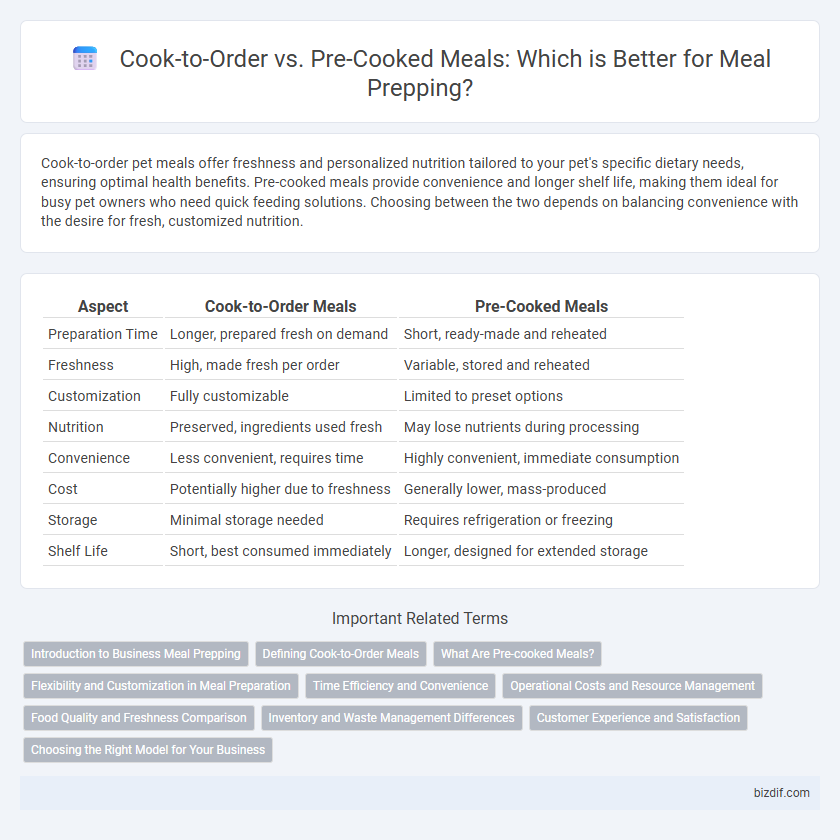Cook-to-order pet meals offer freshness and personalized nutrition tailored to your pet's specific dietary needs, ensuring optimal health benefits. Pre-cooked meals provide convenience and longer shelf life, making them ideal for busy pet owners who need quick feeding solutions. Choosing between the two depends on balancing convenience with the desire for fresh, customized nutrition.
Table of Comparison
| Aspect | Cook-to-Order Meals | Pre-Cooked Meals |
|---|---|---|
| Preparation Time | Longer, prepared fresh on demand | Short, ready-made and reheated |
| Freshness | High, made fresh per order | Variable, stored and reheated |
| Customization | Fully customizable | Limited to preset options |
| Nutrition | Preserved, ingredients used fresh | May lose nutrients during processing |
| Convenience | Less convenient, requires time | Highly convenient, immediate consumption |
| Cost | Potentially higher due to freshness | Generally lower, mass-produced |
| Storage | Minimal storage needed | Requires refrigeration or freezing |
| Shelf Life | Short, best consumed immediately | Longer, designed for extended storage |
Introduction to Business Meal Prepping
Cook-to-order meals offer fresh, customized options tailored to individual preferences, enhancing customer satisfaction in business meal prepping. Pre-cooked meals provide convenience and efficiency by reducing preparation time and streamlining large-scale distribution for corporate settings. Both methods balance quality and operational demands, crucial for optimizing meal prep services in the business environment.
Defining Cook-to-Order Meals
Cook-to-order meals are prepared fresh only after a customer places an order, ensuring optimal flavor and customization based on individual preferences. This approach allows precise control over ingredients, portion sizes, and dietary restrictions, appealing to health-conscious consumers. Unlike pre-cooked meals, cook-to-order dishes prioritize freshness and immediate consumption, reducing the need for preservatives and extensive reheating.
What Are Pre-cooked Meals?
Pre-cooked meals are fully prepared dishes that are cooked in advance and require only reheating before consumption. These meals offer convenience and time-saving benefits, allowing for quick access to ready-to-eat food without the need for extensive cooking. Common examples include frozen entrees, vacuum-sealed meals, and canned soups, which are designed to maintain flavor and nutritional value during storage.
Flexibility and Customization in Meal Preparation
Cook-to-order meals offer unparalleled flexibility and customization, allowing individuals to tailor ingredients, portion sizes, and dietary preferences to their exact needs. Pre-cooked meals provide convenience and time savings but often lack the ability to adjust flavors, ingredient combinations, or accommodate specific dietary restrictions. Choosing between cook-to-order and pre-cooked meals depends on the balance between personalized nutrition and efficient meal preparation.
Time Efficiency and Convenience
Cook-to-order meals require more preparation time but offer fresh customization, ideal for those valuing tailored nutrition. Pre-cooked meals save significant time by eliminating cooking steps, enhancing convenience for busy schedules or quick meal solutions. Both options balance time efficiency and convenience differently, depending on individual lifestyle and dietary preferences.
Operational Costs and Resource Management
Cook-to-order meals typically increase operational costs due to the need for skilled labor, fresh ingredients, and longer preparation times, impacting resource management by requiring real-time inventory monitoring and flexible staffing. Pre-cooked meals reduce labor expenses and streamline kitchen workflows by enabling bulk preparation and standardized portion control, optimizing resource allocation through advance planning and minimized food waste. Choosing between the two approaches depends on balancing customer expectations with cost efficiency and effective use of kitchen resources.
Food Quality and Freshness Comparison
Cook-to-order meals offer higher food quality and freshness by preparing dishes immediately, preserving flavors, textures, and nutritional value. Pre-cooked meals often sacrifice peak freshness due to storage and reheating processes, leading to potential nutrient loss and texture degradation. Consumers prioritizing optimal taste and nutritional benefits typically prefer cook-to-order options over pre-cooked alternatives.
Inventory and Waste Management Differences
Cook-to-order meals require real-time inventory tracking to ensure fresh ingredients are available, minimizing spoilage through precise portioning based on demand forecasts. Pre-cooked meals rely on bulk preparation and storage, which increases the risk of overproduction and waste if demand fluctuates inaccurately. Efficient inventory and waste management systems use data analytics to optimize ingredient usage, reduce excess stock, and lower food waste in both meal prepping methods.
Customer Experience and Satisfaction
Cook-to-order meals provide fresher flavors and customization options, significantly enhancing customer satisfaction by meeting individual preferences and dietary needs. Pre-cooked meals offer convenience and time savings, appealing to customers with busy lifestyles who prioritize quick access to food. Balancing freshness with convenience, meal prepping services must assess customer priorities to optimize overall experience and retention.
Choosing the Right Model for Your Business
Cook-to-order meals ensure freshness and customization, attracting customers seeking personalized dining experiences, while pre-cooked meals offer faster service and consistency, ideal for high-volume operations. Evaluating factors such as kitchen capacity, target market preferences, and delivery logistics helps determine the best model for your business. Balancing quality, speed, and operational efficiency drives profitability in meal prepping ventures.
Cook-to-order vs Pre-cooked meals Infographic

 bizdif.com
bizdif.com